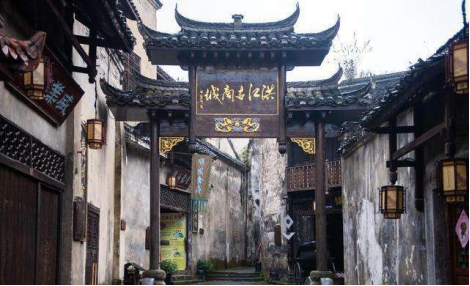Sautéed Duck with Duck Blood and Glutious Rice Cake is a popular delicacy in Hongjiang district. There is an interesting story behind this delicious food.

It is said that during the ruling period of emperor Yongle of the Ming Dynasty (1403-1424), Zheng He1 ordered his men to purchase timber and tung oil in Hongjiang2 and recruited a group of sailors for his sixth voyage to the West. Considering the different eating habits between the north and the south China, sailors from different places were allowed to take some of their own local ingredients, including sweet bean sauce from the north and ginger and dogwood from the south. One of the sailors was Jiang Songfu, a native of Hongjiang, whose mother was a local Miao. On the day he joined the army, in order to pray for good luck for him, his mother made a unique Miao style cake for him by mixing duck blood, salt and glutinous rice.
On the 30th of the first month of the 19th year of Yongle (1421), the huge fleet of the Ming Empire set out from the port of Liujiagang to start the sixth great voyage to the west. One day, when the fleet reached Sumatra, now an island of western Indonesia, Jiang Songfu was cooking duck with ginger and dogwood. He didn’t have any soy sauce, so he used sweet sauce instead. However, the duck meat couldn’t meet the need of the sailors, so he added his special ingredient into it--cakes made of duck blood, salt and glutinous rice. Immediately, the ship was perfumed with fragrance, drawing sailors to vie one another for the delicacy. Wang Jinghong, Zheng He’s adjutant, was also lured to the food. He had a taste of it and spoke highly of it. So he filled a bowl of it to Zheng He, who declined to eat it for the reason he couldn’t stand spicy food. Wang Jinghong hence gave it to his servants and they shared it with each other with great eagerness. After that, Zheng He ordered the crew not to cook this dish during the voyage, saying “It is so spicy that drinking water on board will be soon short in supply.” When the fleet arrived at the coast of East Africa in July of 1421, Zheng He, in order to entertain distinguished guests from the African countries on his ship, asked Jiang Songfu to prepare sautéed duck with duck blood and glutious rice cakes for the banquet. No sooner had the guests had a taste of it than they all gave their thumbs up to it.
When Jiang Songfu returned to Hongjiang from the army, he created a thicker and sweeter sauce based on the northern sweet sauce. Later, his descendant Jiang Bingtang founded Yuanchun Sauce Shop in the fifth year of emperor Xianfeng (1855) of Qing dynasty, who further improved the sweet sauce and replaced dogwood with pepper to make the duck meat fresher, saltier and spicier. Since then, the sautéed duck with duck blood and glutious ricce cakes has become a popular delicacy for every family in Hongjiang and a must on festivals and happy occasions for Hongjiang people.

Notes:
1. Zheng He’s Voyages: Early in the 15th century, a huge fleet of ships set sail from Nanjing, the capital city of Ming Dynasty then. It was the first of a series of voyages that would, for a brief period, establish China as the leading power of the age. The voyage was led by Zheng He, the most important Chinese adventurer of all time and one of the greatest sailors the world had ever known. Zheng He’s voyage to the West was a voyage between the emperors of Yongle and Xuande of Ming Dynasty. The first voyage started in the third year of Yongle (1405), and the last voyage ended in the eighth year of Xuande (1433) , totaling seven times. Zheng He’s voyage to the west was the largest and longest sailing voyage in ancient China. It was also the earliest great maritime exploration in the history of the world, 87 years earlier than Cristoforo Colombo’s voyage in the late fifteenth Century.

2. Hongjiang or Hongjiang Ancient Commercial Town, located on the bank of Yuanshui river, was prosperous because of convenient waterway transportation. It used to be one of the largest, earliest and most complete shopping malls in Southwest China and a leading goods distribution and financial center in the southwest of Hunan, famous for trading timber, tung oil, local medicine and white wax, etc. On currency circulation it was second only to Changsha, the capital city of Hunan. As a result, it had the reputation of “Little Nanjing”, “Pearl of Western Hunan” and “Transportation Hub of Seven Provinces” in the Ming and Qing dynasties.

(Translated by Chen Min)
